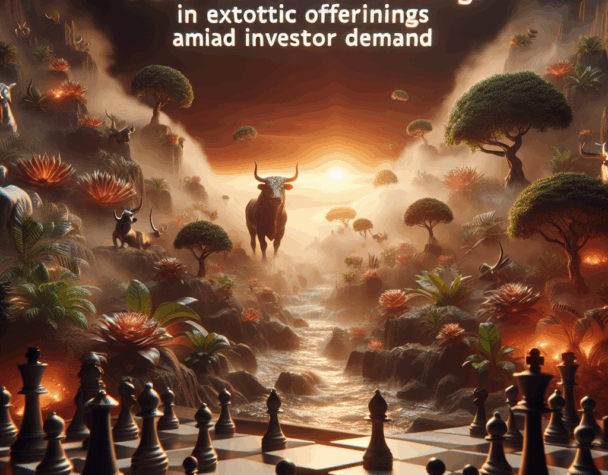
ETF Market Sees Surge in Exotic Offerings Amid Investor Demand
Sat, July 05, 2025ETF Market Sees Surge in Exotic Offerings Amid Investor Demand
The exchange-traded fund (ETF) market is experiencing a significant transformation, marked by the introduction of exotic products and a shift towards active management strategies. These developments are reshaping investment landscapes and offering investors a broader array of options.
Proliferation of Exotic ETFs
In response to growing investor interest in digital assets and speculative investments, fund companies are rapidly launching a wave of exotic ETFs. These include funds tracking cryptocurrencies like cardano and litecoin, memecoins such as dogecoin and $TRUMP, non-fungible tokens (NFTs) like Pudgy Penguins, and even companies allegedly dealing in alien technology. Legal and financial experts suggest this trend signals both a desire by investors for novel investment options and a strategic move by Wall Street to capitalize on the “boredom” of retail investors. ([ft.com](https://www.ft.com/content/86a92a43-c70b-4bf8-899c-d949b43ce698?utm_source=openai))
Active Management Under Scrutiny
Investment managers are facing criticism for promoting ETFs as actively managed while closely mirroring benchmark indices, a practice termed “shy active” by Morningstar. A Carne Group survey found that 88% of wealth managers and institutional investors believe these ETFs fail to meet their active management claims. Transparency concerns, especially due to European regulations mandating daily portfolio disclosures, have impeded the launch of genuinely active ETFs, as managers fear revealing proprietary trades. However, new semi-transparent structures introduced in Luxembourg and Ireland are expected to encourage truly active fund strategies by protecting trade confidentiality. ([ft.com](https://www.ft.com/content/1b4c6b2c-a08d-4d38-b356-6abae01fb085?utm_source=openai))
Record Inflows and Market Challenges
In 2024, U.S. ETFs recorded inflows of $1.1 trillion, nearly doubling the $597 billion from the previous year. Analysts attribute this growth to a bullish market, innovative products in cryptocurrencies and options, and investors’ preference for low-cost, high-liquidity ETFs. However, in 2025, the industry could face challenges such as market saturation and the difficulty of attracting investors to complex products. A record number of ETF closures is expected, surpassing the 186 liquidations of 2024. Despite these challenges, the sector remains optimistic, reaching $14 trillion in global assets by the end of 2024, with a significant increase in new ETF launches, including products based on bitcoin and risk management strategies. ([reuters.com](https://www.reuters.com/markets/us/etfs-could-face-obstacles-2025-after-bumper-year-2025-01-02/?utm_source=openai))
European Market Evolution
The European ETF market has dramatically evolved since the first ETF listings in April 2000, growing into a significant sector with £2.4 trillion in assets by March 2025 and 3,176 products listed across 29 exchanges in 24 countries. The increased variety and reduced costs have opened opportunities for investors, offering nearly 400 global equity ETFs, numerous US-focused options including S&P 500 and Nasdaq 100 trackers, and 45 UK equity trackers, many with total expense ratios (TERs) as low as 0.1-0.2%. However, investors are advised to tread carefully. It’s crucial to evaluate the asset class, index structure, potential benchmark inefficiencies (e.g., Dow Jones Industrial Average or Nikkei 225), and consider factors like currency hedging, active versus passive management, and ETF structure (synthetic vs. physical). While large, cheap ETFs dominate, sometimes more expensive ones offer added features or access to harder-to-trade markets. ([ft.com](https://www.ft.com/content/4d6e1dae-41f3-4229-8f71-6c65934ed796?utm_source=openai))
China’s Market Opening
China is considering granting access to Western firms like Citadel Securities, Jane Street, and possibly Optiver to operate as market makers in its $520 billion ETF market. This move could enhance trading efficiency and reduce costs due to the experience international firms bring in providing ETF liquidity. Over the past two years, China has expanded its ETF sector significantly, growing 134% to become Asia Pacific’s second-largest behind Japan. Despite the growth, ongoing U.S.-China trade tensions, including recent U.S. tariffs of 145% on Chinese goods, may delay approval for U.S. firms. Market makers offer continuous buying and selling prices for ETF shares, enabling smooth trading, and licensed market makers in China benefit from reduced fees and trading restrictions. ([reuters.com](https://www.reuters.com/markets/asia/china-has-considered-opening-its-520-billion-etf-market-western-market-makers-2025-04-11/?utm_source=openai))
Vanguard’s Continued Dominance
Vanguard triumphed over iShares in the US ETF flows competition for the fifth consecutive year in 2024, driven largely by its US equity market trackers. Vanguard’s ETFs received a net inflow of $308.2 billion, including $117 billion for its Vanguard S&P 500 ETF (VOO). iShares attracted $292.5 billion, led by its Core S&P 500 (IVV) with $86.5 billion and its Bitcoin Trust with $37.5 billion. Vanguard’s US equity products made up two-thirds of its new cash, while iShares saw more diversified inflows. Industry-wide, ETFs garnered $1.1 trillion in 2024 inflows, surpassing the 2021 record of $901 billion, with equity funds leading the charge at $773.2 billion. Active ETFs saw $295 billion in inflows, capturing a larger market share of 8.6 percent. ([ft.com](https://www.ft.com/content/9dfe2b66-1c6f-4cb2-8eaf-e9052321f7f9?utm_source=openai))
In conclusion, the ETF market is undergoing rapid changes, with the introduction of exotic products, scrutiny of active management claims, record inflows, and evolving global markets. Investors should stay informed and exercise due diligence when navigating this dynamic landscape.

